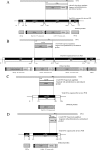Enzyme diversity of the cellulolytic system produced by Clostridium cellulolyticum explored by two-dimensional analysis: identification of seven genes encoding new dockerin-containing proteins
- PMID: 17209020
- PMCID: PMC1899368
- DOI: 10.1128/JB.00917-06
Enzyme diversity of the cellulolytic system produced by Clostridium cellulolyticum explored by two-dimensional analysis: identification of seven genes encoding new dockerin-containing proteins
Abstract
The enzyme diversity of the cellulolytic system produced by Clostridium cellulolyticum grown on crystalline cellulose as a sole carbon and energy source was explored by two-dimensional electrophoresis. The cellulolytic system of C. cellulolyticum is composed of at least 30 dockerin-containing proteins (designated cellulosomal proteins) and 30 noncellulosomal components. Most of the known cellulosomal proteins, including CipC, Cel48F, Cel8C, Cel9G, Cel9E, Man5K, Cel9M, and Cel5A, were identified by using two-dimensional Western blot analysis with specific antibodies, whereas Cel5N, Cel9J, and Cel44O were identified by using N-terminal sequencing. Unknown enzymes having carboxymethyl cellulase or xylanase activities were detected by zymogram analysis of two-dimensional gels. Some of these enzymes were identified by N-terminal sequencing as homologs of proteins listed in the NCBI database. Using Trap-Dock PCR and DNA walking, seven genes encoding new dockerin-containing proteins were cloned and sequenced. Some of these genes are clustered. Enzymes encoded by these genes belong to glycoside hydrolase families GH2, GH9, GH10, GH26, GH27, and GH59. Except for members of family GH9, which contains only cellulases, the new modular glycoside hydrolases discovered in this work could be involved in the degradation of different hemicellulosic substrates, such as xylan or galactomannan.
Figures


References
-
- Ali, E., R. Araki, G. Zhao, M. Sakka, S. Karita, T. Kimura, and K. Sakka. 2005. Functions of family-22 carbohydrate-binding modules in Clostridium josui Xyn10A. Biosci. Biotechnol. Biochem. 69:2389-2394. - PubMed
-
- Bayer, E. A., J. P. Bélaïch, Y. Shoham, and R. Lamed. 2004. The cellulosomes: multienzyme machines for degradation of plant cell wall polysaccharides. Annu. Rev. Microbiol. 58:521-554. - PubMed
-
- Béguin, P. 1983. Detection of cellulase activity in polyacrylamide gels using Congo red-stained agar replicas. Anal. Biochem. 131:333-336. - PubMed
-
- Blanco, J., J. J. Coque, J. Velasco, and J. F. Martin. 1997. Cloning, expression in Streptomyces lividans and biochemical characterization of a thermostable endo-beta-1,4-xylanase of Thermomonospora alba ULJB1 with cellulose-binding ability. Appl. Microbiol. Biotechnol. 48:208-217. - PubMed
MeSH terms
Substances
Associated data
- Actions
- Actions
- Actions
- Actions
LinkOut - more resources
Full Text Sources
Other Literature Sources

